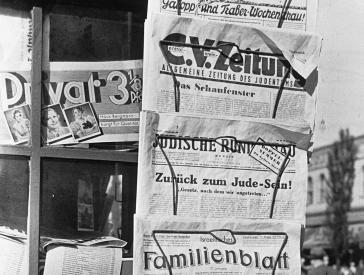"In an Instant. Photographs by Fred Stein"
Press Information
Press Release, Thu 21 Nov 2013
An instant can make the difference - whether in life or in photography. Starting today, the Jewish Museum Berlin is showing more than 130 of such moments captured on the streets of Paris and New York, along with portraits of prominent personalities. This is the world’s first large retrospective of the work of photographer Fred Stein. The exhibition "In an Instant. Photographs by Fred Stein" will run from 22 November 2013 to 23 March 2014, in the Eric F. Ross Gallery.
- Kontakt
-
Press office
T +49 (0)30 259 93 419
presse@jmberlin.de
- Address
Jewish Museum Berlin Foundation
Lindenstraße 9–14
10969 Berlin
At the heart of the exhibition are seventy street scenes from Paris and New York. They are arranged not in a chronological or geographical order, but according to groups of motifs: urban views and everyday situations; street vendors and children; poverty and moments of happiness. These photos are framed by sixty portraits of famous personalities. Personal documents, original prints, and contact sheets cast further light on the life and work of Fred Stein, a photographer whose pictures are more familiar today than is his name.
"Fred Stein’s work shows impressively that he is interested not simply in the photograph, as an outcome of his work, but in the personal encounter and in capturing special moments. That is attested by the anecdotes surrounding the individual pictures," comments the curator Theresia Ziehe.
Psychology of the Portrait
In the course of his life, Fred Stein took more than 1.200 portraits of his contemporaries. These photographs - of social democrats and communists, presidents, writers, intellectuals, and artists - bring together Stein’s respect for the individual person and his interest in the ideas they represented. He drew politicians and artists to the camera with patience and tact, whether it was Salvador Dalí, Marc Chagall, and Willem de Kooning or German emigrants to the United States such as Thomas Mann and Marlene Dietrich. In the opinion of one of his subjects, Hannah Arendt, Stein was among "the best portrait photographers of the present day." Willy Brandt, too, held his friend Fred Stein in high regard. In 1957 he wrote of Stein in New York: "He truly was a man of vision, and his choice of people and subjects is the obvious proof of it." The portraits shown in the exhibition read like a Who’s Who of prominent twentieth-century personalities.
Stein’s visual language is clear and simple; his pictures are not arranged or staged. The photographer worked unobtrusively so that the subjects of his portraits could appear natural. In most cases, he knew their work and biographies long before they arrived, and during the portrait sessions he would immerse himself in conversation, the act of photography becoming almost peripheral. Fred Stein described his photographic aims as follows: "That is the meaning I see in portrait photography: to create a substitute … for the living human being, a picture that says something about the outer and inner person."
The Advocate of the Street
Fred Stein was born in Dresden, the son of a rabbi, and completed his legal training there. As a Jew and a socialist, in 1933 he had to emigrate with his wife Lilo to Paris, then in 1941 onward to New York. In his baggage was his Leica camera, a constant companion up to his death. "Dresden banished me; that’s how I became a photographer," Fred Stein said later. With this small-format camera, and later with a Rolleiflex, the self-taught photographer recorded countless everyday moments on the streets of Paris and New York. Photography became his profession - the trained lawyer became the advocate of the street. Even today, these momentary glimpses are captivating in their liveliness and in their formal and compositional structure. An outstanding observer and chronicler of his era, Fred Stein successfully captured the essence of the two very different metropolises with their characteristic moods. In both cities, he took snapshots that recall scenes from famous movies.
A Legacy Brought to Light
In preparation for the exhibition, the curator Theresia Ziehe studied Fred Stein’s papers in New York in detail. Since Lilo Stein’s death in 1997, his estate has been in the possession of the couple’s son Peter Stein. The earliest photos taken with the Leica are from Stein’s birthplace, Dresden. They are among his oldest surviving works, showing Lilo and Fred Stein, the grave of Stein’s father, who died young, and the Dresden synagogue built by Gottfried Semper. Two of the three surviving contact sheets are presented publicly for the first time in this exhibition.
A fully illustrated publication offers the first comprehensive overview of the photographer’s oeuvre (200 pages, bilingual German / English, Heidelberg: Kehrer Verlag, bookstore edition 49.90 euros)




